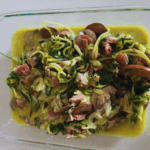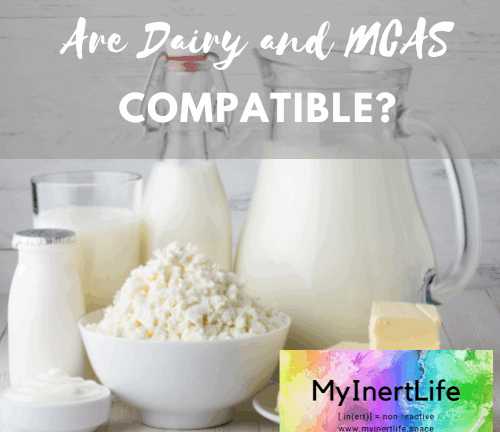Are dairy and MCAS compatible? I often get questions about whether a certain food is alright for a lower histamine diet. Like, “is dairy okay for Mast Cell Activation (MCAS)?”
The answer is, “It depends.”
We are each uniquely different, and when it comes to MCAS each person will have their own unique triggering foods, sensitivities, and off-limits foods.
As an Amazon Associate, I earn from qualifying purchases.
Table of Contents
The truth about dairy and MCAS
Many dairy products are not considered safe on a lower histamine diet because they are cultured (like some kinds of butter, buttermilk, and sour cream), fermented (like yogurt and kefir), or aged (like many kinds of cheese, especially hard cheeses). Culturing, souring, fermenting, and aging all produce histamine in foods, making them high in histamine.
So, generally, I avoid all milk products except mozzarella cheese and ricotta. Both mozzarella and ricotta are “fresh” cheese that are not cultured, fermented, or aged.
The decision to include mozzarella and ricotta in my diet was not one I made lightly. After much trial and error, careful symptom logging, and research, I came to the conclusion that those two forms of dairy were relatively well tolerated. I have been completely dairy-free for years at a time, and I always found that gluten was a bigger trigger of inflammation for me. When I switched to a lower histamine, low-oxalate, sugar-free, low-carb, Keto diet, I was extremely limited in what I could eat. Because mozzarella and ricotta were considered less of a risk for histamine intolerance I gratefully added them back into my diet after some successful trials.
Still, I am careful with ricotta, and only use it the day I open the container. When the container is open for more than a day or two I do notice my symptom progression starting. Mozzarella doesn’t seem to have quite as much potential to build up histamine (at least in my experience), and I can tolerate eating it for several days once opened. And I can also tolerate individual serving-size mozzarella sticks.
What about inflammation vis-a-vis dairy and MCAS?
But besides histamine, dairy products have been implicated in producing and contributing to inflammation in the body. There are a few differing opinions on this topic.
Some people believe that the saturated fat in dairy products causes inflammation.
“… the main fat found in milk is saturated fat, and diets high in saturated fat can increase inflammation.” – Food Insight
While there is another camp that believes dairy doesn’t cause inflammation at all:
“According to new research, dairy foods and milk proteins do not cause inflammation, and in some cases, even combat inflammation.” – Very Well Health
Either way, the casein protein in cow’s milk dairy products is very large in size relative to other proteins and can cause problems during digestion.
https://www.pinterest.com/pin/1054475700229964153/Dairy allergies
Some people have an outright allergy to milk as well.
“Milk allergy occurs when the body’s immune system reacts adversely to the proteins in milk and dairy products and activates an inflammatory response, which can range in severity from rashes to gastrointestinal issues to anaphylaxis.” – Food Insight
A1 vs. A2 milk
Yet another piece of the puzzle is the difference between A1 and A2 milk.
There are two main proteins in milk: Casein and whey. About 80% of the protein in milk is casein, and about 20% is whey. Most casein is in a1 or a2 form.
“The majority of cows produce both a1 and a2 types of casein in approximately equal amounts (5). Some cows have been selectively bred (not genetically modified) to produce only the a2 milk. Goat’s milk and sheep’s milk have mainly a2 casein (6).” – The Celiac MD
“One of the proteins that can trigger a reaction is casein. One explanation for the difference in our ability to tolerate a1 vs. a2 milk is related to casein digestion. As our body is chopping giant casein protein molecules into smaller pieces, a fragment can be released from the a1 protein. This small protein fragment may be the cause of intolerances in dairy (and can be easily confused with lactose-intolerance) (8). A2 milk does not release this same fragment, and thus does not have the same reaction (9).”– The Celiac MD
I have found that I can tolerate small amounts of A2 yogurt if I freeze it in 4 oz. portions immediately after I get it from my supplier. I don’t eat it more than once a week, because I do notice that I have increased inflammation after eating it (as in sore joints). But I welcome a little variety in my diet, and if my bucket is not very full, I take the chance with a little A2 frozen yogurt.
Having a limited diet is hard!
I have tried dozens of variations on a low-inflammatory diet, and if you are in this camp I feel for you! It is not easy! Part of it is emotional because eating is a human activity that we do communally to bond. It’s hard to always be eating something different from your family and friends! Part of the issue is logistical. You have to meal plan, make meals ahead, freeze them, and (if you have histamine intolerance) also worry about how you prepare the food and freeze it right away after it’s cooked. Part of the difficulty is also financial. It can cost a lot more to purchase foods that are organic, whole foods, A2 milk, and specialized versions of foods that contain less histamine.
What is MCAS?
Mast Cell Activation Syndrome (MCAS) is a chronic condition that affects all organ systems. MCAS is serious and disabling and people with MCAS experience often significant and debilitating symptoms daily, including anaphylaxis, which can be fatal.
MCAS is often found in combination with other chronic conditions such as Ehlers-Danlos Syndrome (EDS) and Postural Orthostatic Tachycardia Syndrome (POTS).
Frequently healthcare providers do not know about MCAS, and the tests for MCAS are problematic because they are not uniformly reliable. MCAS can be difficult to manage. Treatments include blocking mast cell mediators with anti-histamines and mast cell stabilizers, as well as avoiding triggers.
Check out this post on how to manage MCAS.
The bucket theory
The Bucket Theory offers a helpful analogy for understanding symptom reactions with MCAS.
Think of your body as an empty bucket that you want to keep from overflowing. Different foods and activities fill your histamine bucket at different speeds but they combine to form the total level of histamine in your body (how full your bucket is). A fuller bucket means you have more histamine symptoms. When you manage triggers, reduce exposure to known triggers, and take medications and supplements to reduce histamine, you can manage the level of your bucket.
Know your typical symptom progression
One of the keys to understanding the level of your bucket is knowing your symptom progression. It is helpful to keep track of the symptoms you are having and to evaluate whether they are escalating. Symptom escalation means that the level of your bucket is rising.
Knowing your symptom progression in a symptom flare is the key to developing your own rescue plan. In this post, I discuss how to determine your own symptom progression. Once you know what typically happens in your symptom progression you can design a rescue plan to address those symptoms.
Get my free ebook, symptom tracker, and meal plan!
Want a tool to easily keep track of your symptoms? Sign up for my newsletter and you will receive my free 50-page ebook of lower-histamine, grain-free, sugar-free, Keto recipes, my free symptom log, and a free two-week meal plan!
Sign up for the SSP!
The Safe and Sound Protocol (SSP) is a listening therapy based on Polyvagal Theory that helps heal nervous system regulation. Many people with MCAS have nervous system dysregulation stemming from infections, toxic exposures, concussions, and trauma. The SSP is an easy-to-use app where you listen to specially filtered music for 30 minutes each day for a 5-hour cycle. Studies show the SSP has a profound effect on mental health and chronic conditions
You can sign up for the SSP here!
Order my book!
Rocks and Roots chronicles my journey solo backpacking the Superior Hiking Trail and overcoming nervous system dysregulation, gut dysbiosis, and Mast Cell Activation Syndrome symptoms to hike 328 miles successfully.
Check out this powerful frequency device
Healy is an individualized microcurrent device I use to reduce inflammation. Check out this post for more about Healy.
Sign up for a session!
I provide one-on-one in-person and remote chronic illness and caregiver coaching and Sacred Self-Healing Sessions based on the Sacred Self-Healing Method, a proven novel co-creative healing modality detailed in my Books.
Click here for more information.
What do you think?
I’d love to have your reply below!
Disclaimer
The preceding material does not constitute medical advice. This information is for information purposes only and is not intended to be a substitute for professional medical advice, diagnosis, cure or treatment. Always seek advice from your medical doctor.




